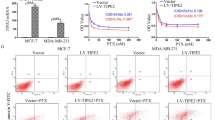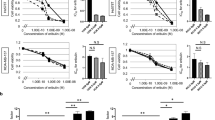Abstract
Purpose
Paclitaxel has been reported to upregulate both AKT and MAPK signaling pathways and thereby compromises its antitumor efficacy. However, tunicamycin has the ability to downregulate AKT and MAPK pathways. The aim of the study is to investigate the antitumor activity of the combination treatment of paclitaxel with tunicamycin and the mechanisms involving the changes of antitumor efficacy.
Methods
Sulforhodamine B (SRB) assay was used to examine the cell viability upon treatment of breast cancer cells with paclitaxel, tunicamycin and the combination of both. Cell cycle distributions and apoptosis were detected by flow cytometry. Western blotting and immunofluorescence staining were used to analyze the effect of drugs on tubulin polymerization. The antitumor growth of combined treatment was measured in nude mice bearing MDA-MB-231 xenograft. Western blotting was performed to explore the alteration of AKT and MAPK pathways in vitro and in vivo.
Results
SRB assay and nude mice experiment showed that tunicamycin synergistically enhanced paclitaxel-induced inhibition of cell proliferation and tumor growth. Tunicamycin had no clear effect on paclitaxel-induced cell cycle arrest, demonstrating that cell cycle distribution was not involved in the enhanced antitumor activity. Both annexin V-FITC/propidium iodide assay and TUNEL assay indicated that the combination of tunicamycin with paclitaxel resulted in significant increased cell apoptosis as compared with individual treatment in vitro and in vivo. Tunicamycin decreased paclitaxel-induced microtubulin polymerization, suggesting that enhanced antitumor effect of paclitaxel was not dependent of microtubulin polymerization. Western blotting analysis confirmed that tunicamycin decreased paclitaxel-induced upregulation of survival signal pathways such as AKT and MAPK.
Conclusion
These results revealed that tunicamycin synergistically enhanced the antitumor effects of paclitaxel through potentiating apoptosis via inhibiting paclitaxel-induced elevation of AKT and MAPK pathways. This study raised the possibility that the combination of paclitaxel with tunicamycin may be a promising approach for improving the clinical activity of paclitaxel.






Similar content being viewed by others
References
Kavallaris M (2010) Microtubules and resistance to tubulin-binding agents. Nat Rev Cancer 10:194–204. doi:10.1038/nrc2803
Marupudi NI, Han JE, Li KW, Renard VM, Tyler BM, Brem H (2007) Paclitaxel: a review of adverse toxicities and novel delivery strategies. Expert Opin Drug Saf 6:609–621. doi:10.1517/14740338.6.5.609
Barbuti AM, Chen ZS (2015) Paclitaxel through the ages of anticancer therapy: exploring its role in chemoresistance and radiation therapy. Cancers (Basel) 7:2360–2371. doi:10.3390/cancers7040897
Okano J, Rustgi AK (2001) Paclitaxel induces prolonged activation of the Ras/MEK/ERK pathway independently of activating the programmed cell death machinery. J Biol Chem 276:19555–19564. doi:10.1074/jbc.M011164200
Hasenstein JR, Shin HC, Kasmerchak K, Buehler D, Kwon GS, Kozak KR (2012) Antitumor activity of Triolimus: a novel multidrug-loaded micelle containing Paclitaxel, Rapamycin, and 17-AAG. Mol Cancer Ther 11:2233–2242. doi:10.1158/1535-7163.MCT-11-0987
Rajput S, Volk-Draper LD, Ran S (2013) TLR4 is a novel determinant of the response to paclitaxel in breast cancer. Mol Cancer Ther 12:1676–1687. doi:10.1158/1535-7163.MCT-12-1019
Subbaramaiah K, Hart JC, Norton L, Dannenberg AJ (2000) Microtubule-interfering agents stimulate the transcription of cyclooxygenase-2. Evidence for involvement of ERK1/2 AND p38 mitogen-activated protein kinase pathways. J Biol Chem 275:14838–14845. doi:10.1074/jbc.275.20.14838
Shtil AA, Mandlekar S, Yu R, Walter RJ, Hagen K, Tan TH, Roninson IB, Kong AN (1999) Differential regulation of mitogen-activated protein kinases by microtubule-binding agents in human breast cancer cells. Oncogene 18:377–384. doi:10.1038/sj.onc.1202305
Yagi H, Yotsumoto F, Sonoda K, Kuroki M, Mekada E, Miyamoto S (2009) Synergistic anti-tumor effect of paclitaxel with CRM197, an inhibitor of HB-EGF, in ovarian cancer. Int J Cancer 124:1429–1439. doi:10.1002/ijc.24031
Low HB, Zhang Y (2016) Regulatory roles of MAPK phosphatases in cancer. Immune Netw 16:85–98. doi:10.4110/in.2016.16.2.85
MacKeigan JP, Collins TS, Ting JP (2000) MEK inhibition enhances paclitaxel-induced tumor apoptosis. J Biol Chem 275:38953–38956. doi:10.1074/jbc.C000684200
Kawaguchi W, Itamochi H, Kigawa J, Kanamori Y, Oishi T, Shimada M, Sato S, Shimogai R, Sato S, Terakawa N (2007) Simultaneous inhibition of the mitogen-activated protein kinase kinase and phosphatidylinositol 3′-kinase pathways enhances sensitivity to paclitaxel in ovarian carcinoma. Cancer Sci 98:2002–2008. doi:10.1111/j.1349-7006.2007.00624.x
Mundi PS, Sachdev J, McCourt C, Kalinsky K (2016) AKT in cancer: new molecular insights and advances in drug development. Br J Clin Pharmacol 82:943–956. doi:10.1111/bcp.13021
Massacesi C, Di Tomaso E, Urban P, Germa C, Quadt C, Trandafir L, Aimone P, Fretault N, Dharan B, Tavorath R et al (2016) PI3K inhibitors as new cancer therapeutics: implications for clinical trial design. Onco Targets Ther 9:203–210. doi:10.2147/OTT.S89967
Hokeness K, Qiu LH, Vezeridis M, Yan BF, Mehta S, Wan YS (2005) IFN-gamma enhances paclitaxel-induced apoptosis that is modulated by activation of caspases 8 and 3 with a concomitant down regulation of the AKT survival pathway in cultured human keratinocytes. Oncol Rep 13:965–969
Han X, Zhang X, Li H, Huang S, Zhang S, Wang F, Shi Y (2015) Tunicamycin enhances the antitumor activity of trastuzumab on breast cancer in vitro and in vivo. Oncotarget 6:38912–38925. doi:10.18632/oncotarget.5334
Giannakakou P, Sackett DL, Kang YK, Zhan Z, Buters JT, Fojo T, Poruchynsky MS (1997) Paclitaxel-resistant human ovarian cancer cells have mutant beta-tubulins that exhibit impaired paclitaxel-driven polymerization. J Biol Chem 272:17118–17125. doi:10.1074/jbc.272.27.17118
Bull VH, Thiede B (2012) Proteome analysis of tunicamycin-induced ER stress. Electrophoresis 33:1814–1823. doi:10.1002/elps.201100565
Mintz M, Vanderver A, Brown KJ, Lin J, Wang Z, Kaneski C, Schiffmann R, Nagaraju K, Hoffman EP, Hathout Y (2008) Time series proteome profiling to study endoplasmic reticulum stress response. J Proteome Res 7:2435–2444. doi:10.1021/pr700842m
Del Grosso F, De Mariano M, Passoni L, Luksch R, Tonini GP, Longo L (2011) Inhibition of N-linked glycosylation impairs ALK phosphorylation and disrupts pro-survival signaling in neuroblastoma cell lines. BMC Cancer 11:525. doi:10.1186/1471-2407-11-525
Jiang CC, Chen LH, Gillespie S, Kiejda KA, Mhaidat N, Wang YF, Thorne R, Zhang XD, Hersey P (2007) tunicamycin sensitizes human melanoma cells to tumor necrosis factor-related apoptosis-inducing ligand-induced apoptosis by up-regulation of TRAIL-R2 via the unfolded protein response. Cancer Res 67:5880–5888. doi:10.1158/0008-5472.CAN-07-0213
Contessa JN, Bhojani MS, Freeze HH, Rehemtulla A, Lawrence TS (2008) Inhibition of N-Linked glycosylation disrupts receptor tyrosine kinase signaling in tumor cells. Cancer Res 68:3803–3809. doi:10.1158/0008-5472.CAN-07-6389
Contessa JN, Bhojani MS, Freeze HH, Ross BD, Rehemtulla A, Lawrence TS (2010) Molecular imaging of N-linked glycosylation suggests glycan biosynthesis is a novel target for cancer therapy. Clin Cancer Res 16:3205–3214. doi:10.1158/1078-0432.CCR-09-3331
Ling YH, Li T, Perez-Soler R, Haigentz M Jr (2009) Activation of ER stress and inhibition of EGFR N-glycosylation by tunicamycin enhances susceptibility of human non-small cell lung cancer cells to erlotinib. Cancer Chemother Pharmacol 64:539–548. doi:10.1007/s00280-008-0902-8
Lanni JS, Lowe SW, Licitra EJ, Liu JO, Jacks T (1997) p53-independent apoptosis induced by paclitaxel through an indirect mechanism. Proc Natl Acad Sci USA 94:9679–9683
Saunders DE, Lawrence WD, Christensen C, Wappler NL, Ruan H, Deppe G (1997) Paclitaxel-induced apoptosis in MCF-7 breast-cancer cells. Int J Cancer 70:214–220. doi:10.1002/(SICI)1097-0215
Bava SV, Puliappadamba VT, Deepti A, Nair A, Karunagaran D, Anto RJ (2005) Sensitization of taxol-induced apoptosis by curcumin involves down-regulation of nuclear factor-kappaB and the serine/threonine kinase Akt and is independent of tubulin polymerization. J Biol Chem 280:6301–6308. doi:10.1074/jbc.M410647200
Mayer IA, Arteaga CL (2016) The PI3 K/AKT pathway as a target for cancer treatment. Annu Rev Med 67:11–28. doi:10.1146/annurev-med-062913-051343
Pritchard AL, Hayward NK (2013) Molecular pathways: mitogen-activated protein kinase pathway mutations and drug resistance. Clin Cancer Res 19:2301–2309. doi:10.1158/1078-0432.CCR-12-0383
Cipriano R, Miskimen KL, Bryson BL, Foy CR, Bartel CA, Jackson MW (2014) Conserved oncogenic behavior of the FAM83 family regulates MAPK signaling in human cancer. Mol Cancer Res 12:1156–1165. doi:10.1158/1541-7786.MCR-13-0289
Schubbert S, Shannon K, Bollag G (2007) Hyperactive Ras in developmental disorders and cancer. Nat Rev Cancer 7(4):295–308. doi:10.1038/nrc2109
Lu Z, Xu S (2006) ERK1/2 MAP kinases in cell survival and apoptosis. IUBMB Life 58:621–631. doi:10.1080/15216540600957438
Kim SH, Juhnn YS, Song YS (2007) Akt involvement in paclitaxel chemoresistance of human ovarian cancer cells. Ann NY Acad Sci 1095:82–89. doi:10.1196/annals.1397.012
Weng D, Song X, Xing H, Ma X, Xia X, Weng Y, Zhou J, Xu G, Meng L, Zhu T et al (2009) Implication of the Akt2/survivin pathway as a critical target in paclitaxel treatment in human ovarian cancer cells. Cancer Lett 73:257–265. doi:10.1016/j.canlet.2008.08.027
Acknowledgements
This work was supported by the National Natural Science Foundation of China under Grant 81272208; and the Jinan Innovation Plan for University and Institution under Grant 201112002.
Author information
Authors and Affiliations
Corresponding author
Ethics declarations
Conflict of interest
The authors declare no competing financial interests.
Ethical approval
All applicable international, national and/or institutional guidelines for the care and use of animals were followed. All procedures performed in studies involving animals were in accordance with the institutional guidelines of the Animal Care and Use Committee of Shandong University.
Rights and permissions
About this article
Cite this article
Huang, S., Wang, D., Zhang, S. et al. Tunicamycin potentiates paclitaxel-induced apoptosis through inhibition of PI3K/AKT and MAPK pathways in breast cancer. Cancer Chemother Pharmacol 80, 685–696 (2017). https://doi.org/10.1007/s00280-017-3393-7
Received:
Accepted:
Published:
Issue Date:
DOI: https://doi.org/10.1007/s00280-017-3393-7




